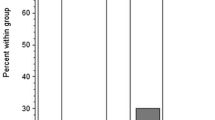Summary
A modification of Wada's finger-tip counting technic for determination of palmar sweat-gland activity is described. The active sweat-gland count of the finger tip was found to be highly reproducible under the conditions of gastric analysis. The modified sweat-gland test and Mushin's salivary-flow technic were used to study the effects of varying doses of two anticholinergic drugs during gastric analyses on 12 patients. Significant correlations were found between the initial value and the maximum drug response for both sweat- and salivary-gland tests. There also was a significant correlation between sweat- and salivary-gland activities in both the basal period and during maximum drug inhibition. The results of this study indicate that the sweat-gland test is an excellent procedure for evaluation of “side effects” of anticholinergic drugs during studies of gastric secretion. This test also is a sensitive method for determining onset of action, peak effect, and duration of action of anticholinergic drugs.
Similar content being viewed by others
References
Grossman, M. I. Inhibition of gastric and salivary secretion by Darbid.Gastroenterology 35:312, 1958.
Mushin, W. W., Galloon, S., andLewis-Faning, E. Anti-sialogogue and other effects of atropine mucate.Brit. M. J. 2:652, 1953.
Wada, M. Sudorific action of adrenalin on the human sweat glands and determination of their excitability.Science 111: 376, 1950.
Edwards, A. L. Statistical Methods for the Behavioral Sciences. Rinehart, New York, 1954.
Kuno, Y. Human Perspiration. Thomas, Springfield, Ill., 1956.
Darrow, C. W. Neural mechanisms controlling the palmar galvanic skin reflex and palmar sweating.Arch. Neurol. & Psychiat. 37: 641, 1937.
Hurley, H. J., Jr., andMescon, H. Localization of specific cholinesterase about the eccrine sweat glands of human volar skin.Proc. Soc. Exper. Biol. & Med. 92:103, 1956.
Randall, W. C. Quantitation and regional distribution of sweat glands in man.J. Clin. Invest. 25:761, 1946.
Wada, M., andTakagaki, T. A simple and accurate method for detecting the secretion of sweat.Tohoku J. Exper. Med. 49: 284, 1948.
Wada, M., Sakurai, M., andTakahashi, Y. Two methods for visualizing sweating on Negro skin.J. Invest. Dermat. 38:55, 1962.
Sutarman andThomson, M. L. A new technique for enumerating active sweat glands in man.J. Physiol. (London) 117:51 P, 1952.
Sivadjian, J. Physiology and topography of the sweat glands.Hygrophotographical studies. Dermatologica 122:460, 1961.
MacKinnon, P. C. B., Gould, A. H., andHarrison, J. Investigation of the palmar sweat count of young male subjects under normal conditions.Psychosom. Med. 24:234, 1962.
MacKinnon, P. C. B., andMacKinnon, I. L. Seasonal sweating.Nature, London 177:799, 1956.
MacKinnon, P. C. B., andHarrison, J. The influence of hormones associated with pituitary-adrenal and sexual-cycle activity on palmar sweating.J. Endocrinol. 23:217, 1961–62.
MacKinnon, P. C. B. Variations with age in the number of active palmar digital sweat glands.J. Neurol., Neurosurg., & Psychiat. 17:124, 1954.
Silver, A., Versaci, A., andMontagna, W. Studies of sweating and sensory function in cases of peripheral nerve injuries of the hand.J. Invest. Dermat. 40:243, 1963.
Herxheimer, A. A comparison of some atropine-like drugs in man, with particular reference to their end-organ specificity.Brit. J. Pharmacol. 13:184, 1958.
Thomson, T. J. Belladonna alkaloids: clinical assessment of the preparation ‘Spansule.’ Glasgow M. J. 36:423, 1955.
Reese, D. R., Free, S. M., Swintosky, J. V., andGrossman, M. I. The effect of dosage forms on the duration and continuity of action of belladonna alkaloids.Am. J. Digest. Dis. 4:220, 1959.
Ihre, B. J. E. Human Gastric Secretion. Oxford, New York, 1939.
Wolf, S., andWolff, H. G. Human Gastric Function. Oxford, New York, 1943.
Brandt, E. N., Jr. Gastric secretion and the law of initial value.Ann. New York Acad. Sc. 98:1291, 1962.
Author information
Authors and Affiliations
Additional information
This work was supported in part by National Institutes of Health Training Grant 5314, and a grant from the A. H. Robins Co., Inc.
Dr. Frederick A. Clark, Jr., suggested use of the finger-tip sweat-gland technic during studies of gastric secretion. Technical assistance was supplied by Robert D. Hicks and Rosa E. Lloyd.
Rights and permissions
About this article
Cite this article
Juniper, K., Stewart, J.R., DeVaney, G.T. et al. Finger-tip sweat-gland activity and saliva secretion as indices of anticholinergic drug effect. Digest Dis Sci 9, 31–42 (1964). https://doi.org/10.1007/BF02232677
Issue Date:
DOI: https://doi.org/10.1007/BF02232677




